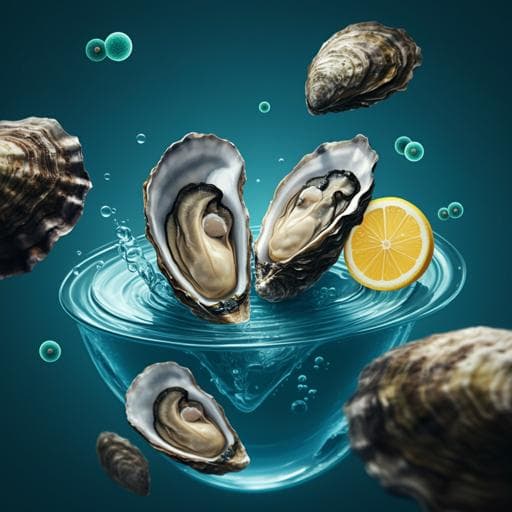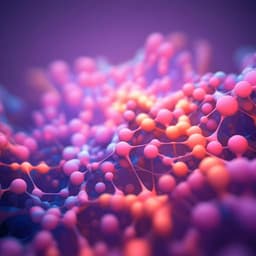
Food Science and Technology
Lactiplantibacillus plantarum 299V-fermented soy whey improved the safety and shelf life of Pacific oysters (Magallana gigas)
L. Chen, Q. Hua, et al.
This innovative research by Lipin Chen and colleagues presents a groundbreaking postbiotic fermentation solution that not only preserves fresh oysters using food waste soy whey but also effectively combats harmful bacteria, enhancing shelf life and safety. Experience a sustainable leap in food preservation like never before!
~3 min • Beginner • English
Introduction
Oysters are highly valued but have a short shelf life and can act as vectors for foodborne pathogens such as Salmonella enterica and Vibrio parahaemolyticus due to bioaccumulation from ambient waters. Biopreservation using lactic acid bacteria (LAB) and their metabolites (postbiotics) offers a safer alternative to chemical preservatives, with documented antimicrobial effects. However, producing sufficient LAB and metabolites typically requires nutrient-rich media that increase costs. Soy whey, a high-volume by-product of tofu production often discarded as waste, contains nutrients and intrinsic antimicrobial compounds that can support LAB growth and enhance preservation efficacy. This study investigates whether L. plantarum 299V-fermented soy whey (FSW) can improve the safety and extend the shelf life of Pacific oysters by suppressing bioaccumulated pathogens and spoilage microorganisms while maintaining chemical quality (TVB-N, biogenic amines) and sensory attributes. The work also explores using the whole fermented system, its cell-free supernatant (FSW-CFS), and cell fraction (FSW-cells), and considers the approach as a sustainable valorization of soy whey and a potential probiotic/postbiotic delivery vehicle.
Literature Review
LAB and their postbiotic metabolites (e.g., organic acids, hydrogen peroxide, diacetyl, bacteriocins) are widely studied for food biopreservation, with applications including coatings and active packaging (e.g., nisin-based films) that inhibit spoilage and pathogens. LAB have been applied in seafood contexts, including oyster depuration to reduce Vibrio parahaemolyticus. Prior work shows soy whey can support LAB growth comparably to MRS and can be transformed into fermented condiments, and it contains phenolics, peptides, saponins, and defensins with antimicrobial potential. L. plantarum 299V can generate antimicrobial phenolic metabolites (e.g., dihydroferulic, dihydrocaffeic, phenyllactic acids). These findings support the feasibility of using soy whey as a sustainable substrate to generate antimicrobial postbiotics for biopreservation of oysters.
Methodology
Bacterial cultures: L. plantarum 299V (commercial probiotic) was cultured aerobically in MRS at 37 °C (48 h passages). Salmonella enterica serovars Typhimurium (ATCC 14028) and Enteritidis (ATCC 13076) were grown in TSB at 37 °C for 24 h; Vibrio parahaemolyticus strains (ATCC 17802, 17803) in TSB + 2% NaCl at 37 °C for 24 h. All were activated for two passages before experiments.
Soy whey preparation: Soybeans were soaked (16 h), homogenized with DI water (1:6 w/v), filtered to obtain soymilk, boiled 5 min, coagulated with MgCl2 (10 g/100 ml; 1:50 addition at 80–90 °C), rested 15 min, pressed to collect soy whey, then pasteurized at 105 °C for 30 min.
Fermentation and treatments: Pasteurized soy whey was inoculated with L. plantarum 299V at ~6.5, ~7.5, or ~8.5 log CFU/mL and incubated at 37 °C up to 72 h with periodic sampling for viable counts and pH. For applications, 24 h fermentation was selected. Treatment groups: (i) FSW: whole fermented soy whey; (ii) FSW-CFS: centrifuge 8000×g, 10 min; filter supernatant through 0.22 μm PTFE; (iii) FSW-cells: collect pellets, wash twice in 1 g/L peptone water, resuspend in sterile water to original volume. Control: sterile DI water.
Oyster handling and storage: Live Pacific oysters (M. gigas) from a Singapore farm were rinsed, shucked, and individually immersed with 40 mL of the designated solution (oysters 15–20 g each). Storage at 4 ± 1 °C. Microbial and chemical analyses at days 0 (30 min post-immersion), 4, 8, and 12.
Pathogen bioaccumulation challenge: Live oysters were acclimated in HDPE tanks with artificial seawater (50 oysters/50 L; 26 g/L salinity) for 4 h at ~22 °C. Seawater was spiked with either Salmonella cocktail (Typhimurium + Enteritidis, 1:1) or V. parahaemolyticus cocktail (ATCC 17802 + 17803, 1:1) to 4.5–5.5 log CFU/mL. After 24 h bioaccumulation, oysters were treated as above and stored at 4 °C. Pathogens were enumerated on days 0, 1, 2, 4.
Microbiological analyses: Individual oysters were homogenized in 0.1% peptone water (1:9). Enumeration on selective media: LAB (MRS, 37 °C, 48 h); psychrophilic total counts (PCA, 15 °C, 7 days); Pseudomonas spp. (Pseudomonas CFC, 30 °C, 2 days); Enterobacteriaceae (VRBG, 37 °C, 24 h); Salmonella (XLD, 37 °C, 24 h); V. parahaemolyticus (TCBS, 37 °C, 24 h). Detection limit was 2.0 log CFU/g.
Chemical quality: TVB-N measured via modified semimicro steam distillation (Kjeldahl apparatus) after homogenization, extraction, distillation with MgO, and titration. Biogenic amines (SPM, SPD, PHE, CAD, PUT, etc.) quantified by HPLC after extraction in 0.6 mol/L perchloric acid, derivatization with dansyl chloride, quenching with ammonia, and filtration.
Texture and color: Texture profile analysis (hardness, springiness, cohesiveness, chewiness) measured over storage. Color measured as L*, a*, b*, and ΔE.
Sensory evaluation: 9-point hedonic scale assessing overall acceptance, appearance, smell, and taste; histogram distributions of scores were reported.
Key Findings
• LAB growth and fermentation kinetics: All inoculation levels (~6.5, ~7.5, ~8.5 log CFU/mL) reached ~8.5 log CFU/mL by 24 h (no significant differences, P > 0.05), then declined by 72 h (<8.0 log CFU/mL). pH dropped from 6.0 ± 0.0 to 3.8 ± 0.1 within 24 h and stabilized. No additional antimicrobial benefit was observed for 48 h vs 24 h fermentation over 12-day oyster storage; thus, 24 h was used.
• Pathogen control (bioaccumulated): In controls, V. parahaemolyticus and Salmonella counts remained stable. FSW and FSW-CFS reduced V. parahaemolyticus to below detection (<2.0 log CFU/g; ~2.0 log CFU/g reduction) by Day 2, and Salmonella to below detection by Day 4 (>1.0 log CFU/g reduction). FSW-cells showed weaker effects: by Day 4, only 1/3 (Vibrio) and 2/3 (Salmonella) replicates fell below detection; others remained ~4.0 and ~3.5 log CFU/g respectively.
• Spoilage microbiota: In controls, psychrophiles, Pseudomonas spp., and Enterobacteriaceae increased markedly (notably from Day 4 to Day 8). FSW and FSW-CFS suppressed Pseudomonas spp. and Enterobacteriaceae to below detection (<2.0 log CFU/g) on Days 4, 8, and 12; psychrophiles were significantly reduced vs control. FSW-cells provided significant but lesser reductions than FSW/FSW-CFS.
• TVB-N: Control increased continuously, exceeding 15 mg/100 g by Day 12 (unacceptable level for oysters). FSW and FSW-CFS kept TVB-N below ~9 mg/100 g at Day 12; FSW-cells reduced TVB-N vs control but less than FSW/FSW-CFS (P < 0.05).
• Biogenic amines: Day 0 hierarchy SPM > SPD > PHE; CAD, PUT, HIS, TRY, TYR not detected initially. Over storage, control showed increases in PHE, CAD, PUT (PUT reached 26.59 ± 0.18 mg/kg at Day 12). FSW and FSW-CFS significantly lowered SPM, SPD, PHE, CAD at Day 12 vs control (P < 0.05), and PUT remained undetected in treated groups.
• Texture and color: Texture attributes declined over time in all groups; however, FSW maintained significantly higher hardness, cohesiveness, and chewiness vs control at Day 12 (values comparable to control at Day 4). Color: FSW maintained higher L* and a* and achieved the lowest ΔE by Day 12 vs other groups, close to Day 0 control values.
• Sensory acceptance: On a 9-point hedonic scale, >60% of participants scored between 6 and 8 for overall acceptance, appearance, smell, and taste. Distributions showed hedonic asymmetry toward positive responses for FSW-treated oysters, indicating favorable market acceptance.
• Mechanistic implication: Comparable efficacy of FSW and FSW-CFS indicates antimicrobial metabolites (organic acids and phenolic-derived compounds from L. plantarum 299V fermentation) are the dominant inhibitory agents; cell-only fraction is less effective at 4 °C due to low metabolic activity.
Discussion
The study demonstrates that fermenting soy whey with L. plantarum 299V rapidly generates antimicrobial metabolites (reflected by a sharp pH drop and known phenolic-derived acids), which effectively migrate into oyster tissues and suppress both bioaccumulated pathogens (V. parahaemolyticus and Salmonella) and spoilage microbiota during chilled storage. The equivalent performance of the whole fermented matrix and its cell-free supernatant underscores that postbiotic components, rather than active bacterial metabolism at 4 °C, drive preservation. Consequently, TVB-N and biogenic amine accumulation were minimized, while texture and color quality were better maintained over 12 days. Sensory results indicate broad consumer acceptability of FSW-treated oysters. Beyond efficacy, the approach valorizes soy whey, a tofu by-product, into a functional preservation solution and prospective probiotic/postbiotic delivery vehicle, aligning food safety, quality, sustainability, and potential health benefits.
Conclusion
A sustainable biopreservation strategy using L. plantarum 299V-fermented soy whey significantly enhanced the safety and extended the shelf life of Pacific oysters during 12 days of refrigerated storage by suppressing bioaccumulated pathogens and spoilage organisms, reducing TVB-N and biogenic amines, and maintaining texture and color. Sensory evaluations showed favorable consumer acceptance. The comparable performance of FSW and its cell-free supernatant highlights the central role of postbiotic metabolites. This technology valorizes soy whey waste and may serve as an innovative vehicle for probiotic/postbiotic delivery. Future work could optimize fermentation parameters, elucidate specific active metabolites and mechanisms, assess scalability and cost-effectiveness, evaluate broader pathogen/seafood matrices, and conduct comprehensive sensory and safety assessments.
Limitations
Related Publications
Explore these studies to deepen your understanding of the subject.







